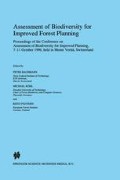Abstract
Specialized model solution approaches can be designed for forest management scheduling problems by utilizing an understanding of the problem. A specialized decomposition approach has made it possible to address larger problems. It has proven successful in applications. Concepts of moving windows from geographic information systems can be combined with dynamic programming (DP) techniques to address adjacency considerations in large problems. This DP approach and the specialized decomposition approach can likely be combined to help identify ways of sustaining both timber production and forest-wide spatial conditions such as the amount of forest edge or interior space. The specialized decomposition approach has been expanded to address spatial interactions between timber markets. Similar expansions seem plausible to address broader spatial environmental concerns related to forest biodiversity.
Access this chapter
Tax calculation will be finalised at checkout
Purchases are for personal use only
Preview
Unable to display preview. Download preview PDF.
References
Borges, J. 1994. A modelling approach to spatial management constraints in forest management. PhD dissertation. University of Minnesota. 117 pp.
Church, R., A. Murray and K Barber. 1994. Designing a hierarchical planning model for USDA Forest Service planning. pp 401–409 in Proceedings of the 1994 Symposium on Systems Analysis in Forest Resources, Sept. 6–9, 1994, Pacific Grove, CA 482 p.
Davis, L. S. and K. N. Johnson. 1987. Forest management. McGraw-Hill, New York. 790 p.
Fisher, M. 1981. The Lagrangian relaxation method for solving integer programming problems. Management Science 27 (1): 1–18.
Hoganson, H. J. Borges and D. Rose. 1994. A dynamic programming approach to solving adjacency problems. in forest management. Paper presented at the 1994 Symposium on Systems Analysis in Forest Resources, September 6–9, 1994, Pacific Grove, California.
Hoganson. H. and D. Kapple. 1995. Estimating impacts of extended rotation forestry. Final research report submitted to the Minnesota Department of Natural Resources. 170 pp.
Hoganson, H. M. and D. C. Kapple. 1991. DTRAN 1.0: A multi-market timber supply model. College of Natural Resources and Agricultural Experiment Station, Department of Forest Resources Staff Paper Series Report No. 82, University of Minnesota, St. Paul. 66 pp.
Hoganson, H., and M. McDill. 1993. Relating reforestation investments in northern Minnesota with forest industry needs, nontimber values and mitigation strategies. research report submitted to the Charles K. Blandin Foundation. 232 p.
Hoganson, H. M. and D. W. Rose. 1984. A simulation approach for optimal timber management scheduling. Forest Science. 30 (1): 220–238.
Hoganson, H. M. and D. W. Rose. 1989. DUALPLAN version 1.0 users manual. College of Natural Resources and Agricultural Experiment Station, Department of Forest Resources Staff Paper Series Report No. 73, University of Minnesota, St. Paul. 48 pp.
Jaakko Pöyry Consulting, Inc. 1994. Generic Environmental Impact Statement on Timber Harvesting and Forest Management in Minnesota. Tarrytown, NY: Jaakko Pöyry Consulting, Inc. 813 p.
Jones, J., J. Meneghin, and M. Kirby. 1991. Formulating adjacency constraints in optimization models for scheduling projects in tactical planning. Forest Science. 37 (5): 1283–1297.
Mladenoff, D., G. Host, J. Boeder and T. Crow. 1996. A spatial model of forest landscape disturbance, succession and management. in: Goodchild, M. et al. eds. GIS and Environmental Modeling: progress and research issues. Fort Collins CO: GIS World Books: 175–179.
Murray, A. T. and R. L. Church. 1994. Adjacency constraint aggregation. pp 131–138 in Proceedings of the International Symposium on Systems Analysis and Management Decisions in Forestry. March 9–12, 193, Valdivia, Chile. 482 p.
Nelson, J., and D. Errico. 1993. Multiple pass harvesting and spatial constraints: an old technique applied to a new problem. Forest Science. 39 (1): 1–15.
Paredes V., G., and J. Brodie. 1989. Land value and the linkage between stand and forest level analyses. Land Economics. 65 (2): 158–166.
Sessions J. and J. Sessions. 1988. Scheduling and network analysis program (SNAP). User’s Guide. Dept. of Forest Management. Oregon State University. Corvallis OR.
Snyder, S. and C. ReVelle. 1996. The grid packing problem: selecting a harvest pattern in an area with forbidden regions. Forest Science. 42 (1): 27–34.
Weintraub, A., F. Barahona and R. Epstein. 1994. A column generation algorithm for solving general forest planning problems with adjacency constraints. Forest Science. 40 (1): 142–161.
Author information
Authors and Affiliations
Editor information
Editors and Affiliations
Rights and permissions
Copyright information
© 1998 Springer Science+Business Media Dordrecht
About this chapter
Cite this chapter
Hoganson, H., Borges, J., Bradley, D. (1998). Techniques for Addressing Spatial Detail in Forest Planning. In: Bachmann, P., Köhl, M., Päivinen, R. (eds) Assessment of Biodiversity for Improved Forest Planning. Forestry Sciences, vol 51. Springer, Dordrecht. https://doi.org/10.1007/978-94-015-9006-8_17
Download citation
DOI: https://doi.org/10.1007/978-94-015-9006-8_17
Publisher Name: Springer, Dordrecht
Print ISBN: 978-90-481-4962-9
Online ISBN: 978-94-015-9006-8
eBook Packages: Springer Book Archive

